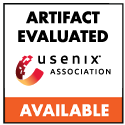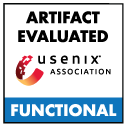Tobias Cloosters, University of Duisburg-Essen; Johannes Willbold, Ruhr-Universität Bochum; Thorsten Holz, CISPA Helmholtz Center for Information Security; Lucas Davi, University of Duisburg-Essen
Intel's Software Guard Extensions (SGX) provide a nonintrospectable trusted execution environment (TEE) to protect security-critical code from a potentially malicious OS. This protection can only be effective if the individual enclaves are secure, which is already challenging in regular software, and this becomes even more difficult for enclaves as the entire environment is potentially malicious. As such, many enclaves expose common vulnerabilities, e.g., memory corruption and SGXspecific vulnerabilities like null-pointer dereferences. While fuzzing is a popular technique to assess the security of software, dynamically analyzing enclaves is challenging as enclaves are meant to be non-introspectable. Further, they expect an allocated multi-pointer structure as input instead of a plain buffer.
In this paper, we present SGXFUZZ, a coverage-guided fuzzer that introduces a novel binary input structure synthesis method to expose enclave vulnerabilities even without source-code access. To obtain code coverage feedback from enclaves, we show how to extract enclave code from distribution formats. We also present an enclave runner that allows execution of the extracted enclave code as a user-space application at native speed, while emulating all relevant environment interactions of the enclave. We use this setup to fuzz enclaves using a state-of-the-art snapshot fuzzing engine that deploys our novel structure synthesis stage. This stage synthesizes multi-layer pointer structures and size fields incrementally on-the-fly based on fault signals. Furthermore, it matches the expected input format of the enclave without any prior knowledge. We evaluate our approach on 30 open- and closed-source enclaves and found a total of 79 new bugs and vulnerabilities.
Open Access Media
USENIX is committed to Open Access to the research presented at our events. Papers and proceedings are freely available to everyone once the event begins. Any video, audio, and/or slides that are posted after the event are also free and open to everyone. Support USENIX and our commitment to Open Access.

author = {Tobias Cloosters and Johannes Willbold and Thorsten Holz and Lucas Davi},
title = {{SGXFuzz}: Efficiently Synthesizing Nested Structures for {SGX} Enclave Fuzzing},
booktitle = {31st USENIX Security Symposium (USENIX Security 22)},
year = {2022},
isbn = {978-1-939133-31-1},
address = {Boston, MA},
pages = {3147--3164},
url = {https://www.usenix.org/conference/usenixsecurity22/presentation/cloosters},
publisher = {USENIX Association},
month = aug
}

